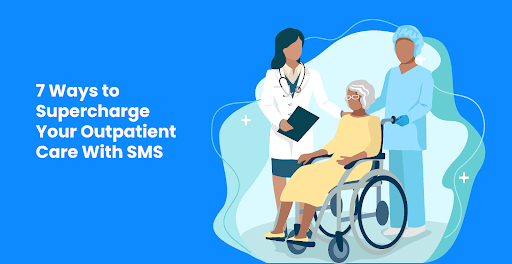You run a busy healthcare facility or practice. Hundreds of patients need your care and attention.
However, you have limited time, resources, and staff.
How do you keep up with the demand even after they leave your facility?
How do you communicate with them effectively without overwhelming them or yourself?
We’ll share 7 proven ways to use SMS to supercharge your outpatient care.
By the end of this article, you’ll have a clear idea of how to leverage SMS to improve your patient care and experience.
Let’s get into it.
| SMSCountry is the best bulk SMS service to delight your patients. Learn more about our SMS services. Get started or schedule a demo. |
Importance of providing good care to out-of-office patients
Let’s, for a moment, wear the shoes of your patient. They have been diagnosed with a terminal illness.
Now, they have two options:
- Stay in the hospital and get subjected to invasive tests, painful treatments, and impersonal care.
- Go home and get surrounded by loved ones, a familiar environment, and supported by a dedicated team of health care providers.
Which option would they likely choose?
In today’s world, most patients would prefer the second option. So, developing effective strategies for outpatients has never been more crucial.
Outpatients (or out-of-office patients) are also referred to as ambulatory patients. They’re those who receive medical care outside of the typical hospital or clinic setting.
Of course, with the Mayo Clinic reporting a 78.9% increase in engagement, outpatient care tends to offer more value.
However, providing quality care to outpatients is challenging. The number 1 challenge you’ll face is a lack of effective doctor-patient communication.
As a result, you do not want to miss the next session.
How can SMS enhance your outpatient care?
The stats don’t lie.
SMS is the most effective way to communicate with your out-of-office patients.
It helps you:
- Remind them of their appointments, medications and test results.
- Provide them with health education and tips.
- Encourage them to stick to their treatment plans and lifestyle changes.
- Monitor their symptoms and progress.
- Solicit feedback and satisfaction.
- Alert them of any changes or updates in your services.
- Save time, money, and resources.
How to use SMS to improve out-of-office patient care?
To help out-of-office patients manage their health, you’ll need effective follow-up.
However, this can be expensive. That’s where SMS comes in. It is cost-effective and has the highest open rates.
Here’s how to improve outpatient care via SMS.
#1. Establish better doctor-patient communication
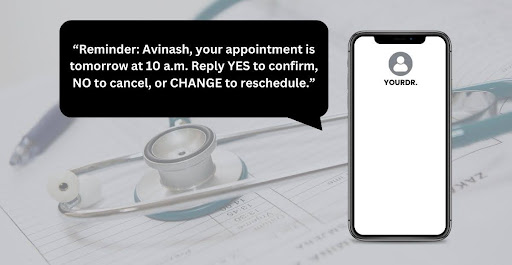
Communication builds rapport with patients.
However, communication can get complex when patients are out of the office. They may get busy, forgetful, or need access to phone calls or emails.
Here’s how SMS can solve communication problems:
- SMS reduces no-shows: Send text reminders for appointments, rescheduling, and cancellations. Here’s an example. “Reminder: Avinash, your appointment is tomorrow at 10 a.m. Reply YES to confirm, NO to cancel, or CHANGE to reschedule.”
- Patients can ask questions: SMS can allow you to have a two-way conversation with your patients, where they can ask you questions or share their concerns about their health or treatment. Here’s an example. “Ted, do you have any questions or concerns about your health or treatment? Reply to this message, and we’ll respond soon.”
- Patients get quick responses through SMS: You can also send them links to videos or websites to give them more information. Here’s an example. “Celine, We hope you are doing well. Here’s a video link explaining more about your condition and treatment: https://example.com/video.”
#2. Manage medication easier
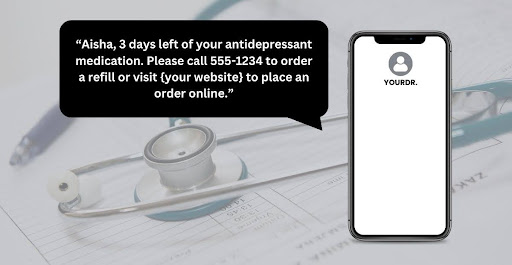
Many patients struggle with remembering to take their medications on time. Or refilling their prescriptions before they run out.
This can lead to poor health outcomes, complications, and increased costs.
SMS can help patients avoid these problems by:
- Sending SMS reminders for taking medications on time: Send automated messages to remind patients to take their medications. For example: “Hi, Jason. It’s time to take your blood pressure pill. Take one tablet of lisinopril 10 mg with a glass of water.”
- Providing alerts for refilling prescriptions through SMS: Patients can avoid running out of medication or worsening their condition. For example, an SMS alert could say: “Aisha, 3 days left of your antidepressant medication. Please call 555-1234 to order a refill or visit our website to place an order online.”
- Sharing helpful tips and resources through text messages: SMS can also give patients valuable tips and resources to help them manage their medication better. For example: “Hi [First Name], get [Percentage]% off your next [Product/Service] with code [Code]. Ends on [Date]. Visit [this website] for tips on your [Medication Name]. [Company Name] cares”
#3. Provide instructions and follow-up care
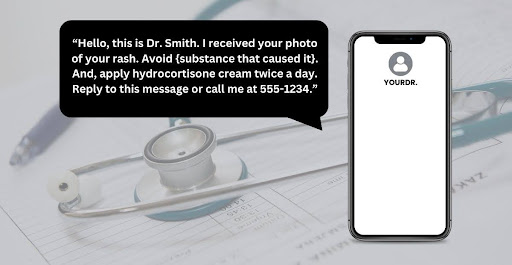
After a visit, patients must undergo recovery and prevent complications. Hence, they need to schedule another visit or consult with their doctor.
Here’s how SMS makes this easier:
- Post-visit instructions and care guidelines: You can send information on how to care for a wound, symptoms to watch out for, and how to take medication. Plus, there are links to online resources on how to perform specific actions. For example: “David, thank you for visiting us today. Please follow these steps to care for your stitches: {link}. Questions? Please reply to this message or call us at 555-1234.”
- SMS reminders on tests or procedures: You can remind patients what documents to bring for procedures. For example: “You have a follow-up appointment tomorrow at 10 am with Dr. Smith. Please bring your blood test results and your insurance card. To confirm, reschedule, or cancel your appointment, please reply YES, NO, or LATER.”
- Offering remote consultations through SMS: This can be useful for patients with mobility issues. You can provide advice, diagnosis, treatment, or referrals via SMS. Here’s an example. “Hello, this is Dr Smith. I received your photo of your rash. Avoid {substance that caused it}. And apply hydrocortisone cream twice a day. Reply to this message or call me at 555-1234.”
| See the top bulk SMS service providers to send notifications and updated SMS to your patients. If you provide an online service, app or portal, check out the top OTP service providers to send fast and secure OTPs. |
#4. Deliver test results and health updates faster
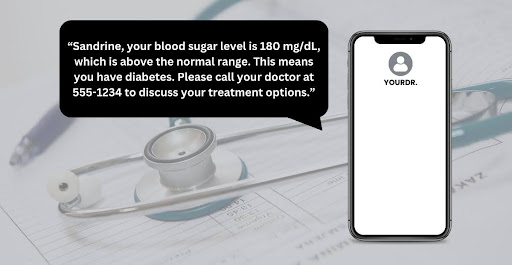
Do you want to send patients their test results or health updates? Easy-peasy.
Patients don’t have to wait for a phone call or an email. Send the results and updates via SMS when they are available.
This improves patient satisfaction, reduces anxiety, and enables timely action.
Here’s what to do:
- Send SMS notifications with test results promptly: Include their test results or a link to view them online. Also, include information about what the results mean and what the next steps are. Or who to contact for more details. Here’s an example. “Sandrine, your blood sugar level is 180 mg/dL, above the normal range. This means you have diabetes. Please call your doctor at 555-1234 to discuss your treatment options.”
- Provide health updates and advice through text messages: You can also use SMS interactive features like surveys, quizzes, or feedback requests to engage patients and monitor their health status. Here’s an example. “You have completed 4 weeks of your chemotherapy. How are you feeling today? Reply with 1 for very good, 2 for good, 3 for fair, 4 for poor, or 5 for very poor.”
- Allow patients to request and receive medical reports via SMS: Patients can send a text message with a code or a keyword to request their test results or medical reports. Then, receive them via SMS or a link to download them. Here’s an example. “Hi Patrick, text “REPORT” to 555-1234 and receive a link to download your medical report.”
#5. Promote healthier habits and preventive measures
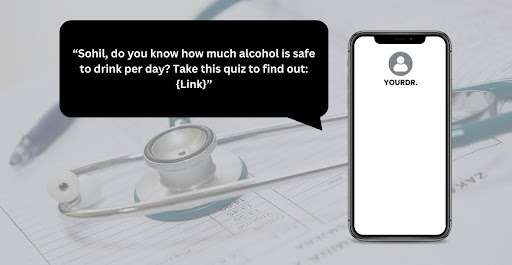
You can use SMS to promote healthier habits and preventive measures. It helps patients adopt and maintain a healthy lifestyle.
This way, they can reduce the risk of chronic diseases or complications.
Here’s how:
- Share SMS tips: Send incentives or challenges to encourage patients to stick to their goals and plans. Take for instance: “Eating more fruits and vegetables can moderate your blood pressure and cholesterol levels. Try adding one serving of fruit or vegetable to each meal today.”
- Offer educational resources: Send links to videos, websites, podcasts, or articles with relevant information. Try interactive features like quizzes, games, or polls to test patient knowledge and provide feedback. For example: “Sohil, do you know how much alcohol is safe to drink daily? Take this quiz to find out: {Link}”
- Send reminders: Inform patients of the importance of preventing severe diseases or complications. Use SMS to schedule, confirm, reschedule, or cancel patients’ appointments for these services. For example: “You are due for a mammogram this month. It’s a screening test to detect breast cancer early and save your life. To schedule your appointment, please reply YES.”
#6. Ensure patient privacy and security
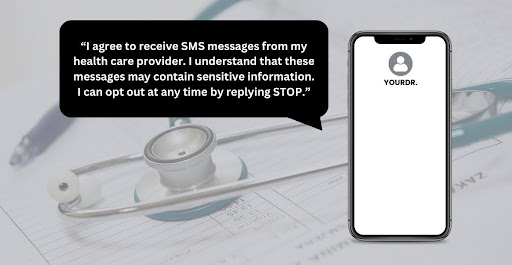
SMS messages can contain sensitive information like test results, diagnoses, prescriptions, or personal details.
These confidential messages can be intercepted, lost, or stolen.
You must maintain patient confidentiality and trust. And what better way to do this than via SMS?
- Use a secure SMS platform to ensure patient data encryption: SMS messages are not secure by default. They can be hacked or intercepted. That’s why SMSCountry encrypts, authenticates, and audits your messages – to protect your patient data.
- Obtain patient consent and follow privacy regulations: You can obtain consent verbally, electronically, or in writing. For example, a consent form could say: “I agree to receive SMS messages from my health care provider. I understand that these messages may contain sensitive information. I can pull-out at any time by replying STOP.”
- Educate staff on SMS security practices: Staff should follow best practices on using SMSCountry and deleting SMS messages after use. A staff training session could cover topics like: “What types of information can and cannot be sent via SMS?” “How to delete SMS messages after use”, and “How to report incidents”.
#7. Track for continuous improvement
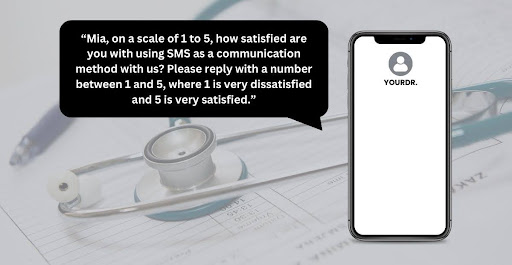
You can’t improve what you don’t measure.
In light of this, you must track the performance of your SMSes.
- Track SMS engagement and patient feedback: Did patients interact with SMS messages? Track your open rate. And measure how many patients reply to the SMS messages they receive.
- Analyse data for better out-of-office patient care: Data analysis shows patterns, trends, correlations, or anomalies in the data that can reveal areas for improvement. For example, a regression analysis could measure how SMS engagement affects patient outcomes.
- Request patient feedback to refine your SMS strategies: Use surveys, polls, focus groups, interviews, reviews, or testimonials with SMS. Here’s an example. “Mia, on a scale of 1 to 5, how satisfied are you with using SMS to communicate with us? Please reply with a number between 1 and 5, where 1 represents dissatisfaction, and 5 is satisfaction.”
These 7 strategies make SMS robust and reliable. Renowned healthcare providers can attest to this.
| Want to do all of these on WhatsApp instead of via SMS? Get our WhatsApp messaging solution Today! |
Case studies and success stories
Many healthcare providers have successfully implemented SMS strategies and campaigns.
Now, their communication has improved. And patients are more engaged and satisfied.
Here are examples of healthcare providers using SMS to make a difference in out-of-office patient care.
#1: Actium Health
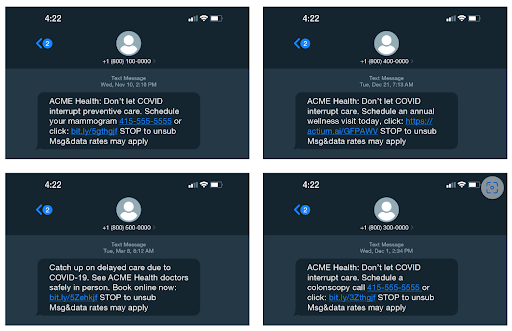
Actium Health is a digital health marketing company. They partner with healthcare providers to boost patient care using innovative methods.
Their main strategy? SMS, of course. They send personalised and timely SMS messages to patients across different service lines.
This includes orthopaedics, cardiology, oncology, and primary care. These SMSes remind your patients of their appointments. They educate them about their conditions and treatments.
And most importantly, they use SMS to collect patients’ feedback on their experiences.
And like a lion let loose, Actium Health achieved impressive results:
- Patient scheduling increased by 30%
- Scheduled appointments of 400% more than planned (in just two weeks), and
- 50% engagement from patients within 24 hours.
Now, that’s the power of SMS. Another healthcare witness to the power of SMS?
#2: Health Catalyst
Health Catalyst is a data analytics company. They stand as intermediaries between healthcare providers and their patients.
They help healthcare providers improve the quality and efficiency of care.
How? Via SMS.
They use SMS to collect data from patients. These data give them invaluable insights and recommendations.
Health Catalyst also uses SMS to monitor patients’ health status and intervene when needed.
This has helped healthcare providers reduce costs, errors, and complications.
For example, Health Catalyst helped Allina Health reduce hospital readmissions by 27%. They sent SMS messages to heart failure patients after discharge.
This helped the patients feel valued and loved. And, of course, it boosted their recovery process.
You can have your own success stories, too. How? Find out in the next section.
SMS best practices to help you get the best results
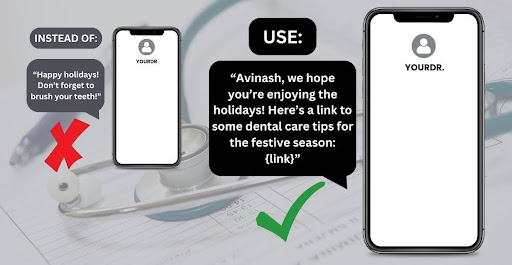
You know how powerful SMS is in reaching your outpatients.
But do you know how to use it effectively?
Here are tips to make your SMS campaigns more engaging, conversational and compliant:
- Choose a secure and reliable SMS platform: Use the most secure SMS platform. They’ll encrypt, authenticate, and audit your messages.
- Get patients’ consent by all means: They must agree to receive SMS messages. So, let them know their rights and responsibilities, including how to opt-out.
- Use clear and concise language: Ditch medical jargon, abbreviations, or acronyms. Use simple and direct sentences that convey your message clearly and politely.
- Personalise your messages: Address your patients appropriately by their names. Tailor your message to suit their needs. It’ll increase their engagement and response rates.
- Provide value and relevance: Respect your patient’s preferences and frequency of communication.
Copy, tweak and use SMS messages from our library of healthcare SMS templates.
We created a guide on 8 ways to prepare your healthcare facility for emergencies. But in this guide, we’d give you a quick checklist.
Your ultimate healthcare emergency checklist
During a healthcare emergency, you must act quickly and calmly.
Here are vital steps to take at each stage of an emergency.
Stage #1: Before the emergency
Take these steps before any emergency:
- Conduct a facility-based hazard vulnerability analysis (HVA): Identify potential threats and prioritise preparedness actions.
- Develop an emergency operations plan (EOP): It should cover all aspects of the emergency response, including incident command, communication, continuity of essential services, shelter-in-place and evacuation, surge capacity, resource management, and recovery.
- Establish a multidisciplinary emergency management committee: They’ll help oversee the implementation and evaluation of the EOP.
- Assign roles and responsibilities to staff members: Train them on the EOP and their specific tasks.
- Keep adequate supplies and equipment for emergency response: Equipment such as personal protective equipment (PPE), medications, oxygen, generators, water, and food.
- Establish communication channels with stakeholders: Establish communication channels with internal and external stakeholders like local authorities, other healthcare facilities, and media.
- Conduct regular drills and exercises: This enables you to test and improve the EOP and staff readiness.
Stage #2: During the emergency
Ensure to apply these best practices during any hospital emergency:
- Activate the EOP and the incident command system (ICS) immediately.
- Identify the primary and secondary sites for ICS operations. And ensure they’re functional and secure.
- Communicate clearly and frequently with staff, patients, families, and external partners. Relay information about the situation and the actions taken.
- Manage patients according to their severity and needs.
- Provide essential care for staff and patients. This can include hydration, nutrition, hygiene, and psychosocial support.
- Monitor and document the status of patients, staff, resources, and facilities.
- Adjust to changing demands and challenges as the emergency evolves.
Stage #3: After the emergency
After the emergency, do this:
- Deactivate the EOP and the ICS when the situation is under control.
- Restore normal operations as soon as possible.
- Conduct a debriefing session with staff and stakeholders. There, review the emergency response and identify strengths and weaknesses.
- Provide feedback and recognition to staff for their performance and contribution.
- Address any physical or mental health issues caused by the emergency. Do this for both staff and patients.
- Evaluate the EOP. Update it based on lessons learned from the emergency.
This is your ultimate healthcare emergency checklist. Keep it handy and review it regularly.
Remember, adequate preparation makes a difference in a crisis.
Use SMSCountry to communicate faster and better
SMS makes providing quality care for your outpatients possible and more innovative.
SMS is fast, convenient, affordable, and secure. It’s the perfect tool for your outpatient care.
But, to supercharge your outpatient care, you’ll need a reliable and trusted SMS partner.
SMSCountry is the leading provider of SMS solutions for healthcare businesses.
With SMScountry, you can improve your appointment scheduling, reminders, feedback, surveys, health tips, and follow-ups. Enjoy flexible plans, easy integration, and dedicated support.
Don’t wait any longer. Sign up for free now or request a demo to start and see for yourself.
Our team is waiting to serve you.
FAQs
How can I start using SMS for my outpatient care?
Here’s how to start using SMS for your outpatient care:
- Choose a versatile, reliable, and secure SMS service provider
- Obtain consent from your patients to communicate with them via SMS
- Set up your SMS campaigns and templates
- Monitor and measure the results of your SMS campaigns. Then, make adjustments as needed.
What is SMS, and how can it improve outpatient care?
SMS stands for Short Message Service. It’s a text messaging service that allows users to send and receive short-form messages via mobile devices. SMS is convenient and cost-effective, especially when using a renowned bulk SMS service. Healthcare providers can also send multiple personalised SMSes to many patients at once.
How can I use SMS to send appointment reminders to my patients?
SMS service providers allow you to schedule and automate your text messages. You can also customise the content and frequency of the messages. You can include the appointment’s date, time, location, and purpose. You can also ask your patients to confirm or reschedule their appointments via SMS.
How can I use SMS to follow up on my patient’s health status?
You can use SMS to follow up on your patient’s health status. Simply send them periodic SMS messages. Ask them about their symptoms, medication adherence, satisfaction, and feedback. You can also use SMS to monitor their vital signs. Like blood pressure, glucose level, or weight, by asking them to send you their readings via text. You can then use this data to track their progress and regulate their treatment plan accordingly.
How can I use SMS to provide health education and support to my patients?
You can send an SMS containing relevant information about their condition, treatment, prevention, and self-care. You can also use SMS to motivate and encourage your patients. Send them positive affirmations, tips, or reminders.
What are the benefits of using SMS for outpatient care?
Using SMS offers multiple benefits for outpatient care, including:
- Improved patient engagement and satisfaction
- Reduced no-shows and cancellations
- Improved patient outcomes and quality of care
- Reduced costs and workload via automated and streamlined SMS processes and
- Increased accessibility and reach as SMS is widely used.
What are the challenges of using SMS for outpatient care?
The challenges of using SMS for outpatient care include:
- Ensuring patient privacy and security compliance with relevant laws and regulations like HIPAA.
- Obtaining patient consent and preference. At the same time, allow them to opt in or opt-out.
- Managing patient expectations and boundaries. Like setting clear rules and guidelines for using SMS. And deciding the messages’ frequency, timing, content, and response time.
- Evaluating the effectiveness and impact of using SMS
What are the best practices for using SMS for outpatient care?
Here are 5 best practices for using SMS for outpatient care:
- Be prompt and attentive to patients’ needs
- Use simple language that is uncomplicated and easy to understand.
- Use short messages that convey the main point or action
- Use appropriate tone and style that match the purpose of the message
- Personalise your SMS. Always address the patient by name and reflect their specific needs and preferences
- Use feedback and confirmation that acknowledge the patient’s response. Also, provide confirmation and clarification.
What are some examples of SMS messages for outpatient care?
Some examples of SMS messages for outpatient care are:
- Appointment reminder: “Hi John, this is Dr. Smith from ABC Clinic. Just a gentle reminder that you have an appointment with me tomorrow at 10 am. Kindly reply YES to confirm or NO to reschedule.”
- Health status follow-up: “Hi John, this is Dr. Smith from ABC Clinic. How are you feeling today? Please reply with a number from 1 (very bad) to 10 (very good).”
- Health education: “Hi John, this is Dr. Smith from ABC Clinic. Here is a tip for managing diabetes: Check your blood sugar level before each meal and two hours after. Aim for 80-130 mg/dL before meals and less than 180 mg/dL after meals.”
- Health support: “Hi John, this is Dr. Smith from ABC Clinic. You are doing great with your diabetes management! Keep up the good work! Remember, I am here to help you with any questions or concerns.”


